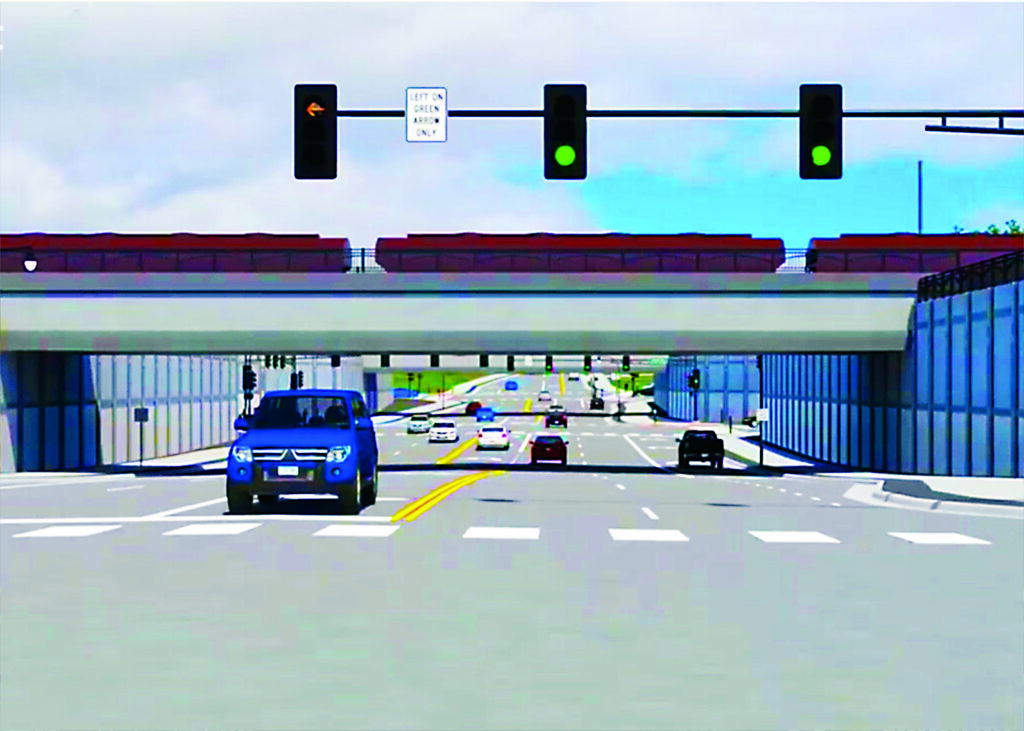Second underpass project moving forward

Simulated view of 11th Street looking north from Main Avenue. Illustration/Minnesota Department of Transportation.
With part of a long-awaited train-dodging solution nearly in place on the east side, Moorhead is turning its attention to another answer to drivers’ prayers – the double underpass planned nearer downtown.
Drivers will be able to bypass traffic-blocking trains near Moorhead High School in just a couple more weeks. The SE Main/20-21st Street underpass – four years in the making – is expected to open by the middle of July.
Now, says city engineer Bob Zimmerman, is a good time to think about the benefits the proposed double underpass (or “grade separation project”) on 11th Street will bring to those seeking to dodge delays along the BNSF tracks.
The 11th Street project has been in the dream stage even longer than the one to the east. “I could show you conceptual plans for a downtown underpass going back to the 1970s,” the engineer says. “a study was initiated back in 2008 to consider where the project could be built. This location (north of Hornbacher’s) was deemed the best.”
If the four-year process of carrying vehicles under the tangle of BNSF and Otter Tail Railway tracks along the Highway 52 intersection seems enormous, the planning for the 11th Street undertaking is even larger. It involves not one, but two, underpasses – one for the tracks between Main and Center Avenues, the other between Center and First Avenue North. It involves the courses of both U.S. Highways 75 and 10. And, coming up at a time of inflation, its cost is being boosted beyond the features it entails.
The Minnesota Department of Transportation is the lead agency for 11th Street, with extensive input from at least four members of Moorhead’s 17-person engineering department. It’s using an approach quite different from the norm, one usually reserved for very large projects. (At a projected cost of $114.7 million, this one is on the small side.) It has involved both a design engineer and a construction manager from the very beginning.
“Normally, an engineer comes up the design. Then the project is bid, and the winning construction company steps in,” Zimmerman explains. “MNDoT has hired both, and they’re working jointly. That way, they get the perspective of the contractor from the beginning of the process. It should enable them to identify areas where changes in design can increase the efficiency and cost savings, along with accounting for the degree of risk.”
On the design side is WSB, a Twin Cities design and consulting firm. Civil and industrial general contractor Ames Construction is providing the hands-on expertise. The company is a familiar one; it is in charge of the SE Main/20-21st project, as well as three of the FM Diversion’s main structures. According to Zimmerman, the Twin Cities firm won the nod to participate in the design phase through a competitive bid project. It will provide a cost estimate when the final design is complete. If deemed reasonable, Ames will continue on through construction. If MNDoT questions its numbers, the project may be opened up for wider bidding.
The city engineer says the design phase will be completed in early 2023. Some utilities relocation may begin that summer, but most of the construction is slated for 2024 and 2025. “We’re looking closely at the staging,” he notes. “There will be some times when parts of 11th Street will be closed, but never all three intersections at the same time. We need to balance the efficiencies of closing the road with the impact on the public. What impacts will be acceptable, and for how long?”
While the financing is largely in place, MNDoT and its local city and county partners have applied for four different federal infrastructure grants that will affect the state and local cost. “The state has allocated in the neighborhood of $65 million,” Zimmerman says. “The balance will come from Moorhead, Clay County and the MNDoT budget.” If the grants are awarded, it will have a big effect on the local share. The target for the city, he says, is $3.5 million; without federal money, that figure could double. Likewise, Clay County’s target share of $500,000 could rise as high as $2 million.
Zimmerman says the four-year course of the $72 million undertaking along SE Main/20-21st has given everyone an opportunity to learn even more about the region’s notoriously challenging soil conditions. “Engineers have ideas. We don’t have all the answers,” he suggests wryly. “Our experience on the other project was one of the driving factors in using this unusual design process. We wanted to take advantage of what all of us have learned.”
At the root of the challenge is the peculiar heavy clay that lies under Moorhead’s – and the whole Red River Valley’s – feet. Blame it on the glaciers and ancient Lake Agassiz. “The soil here is really weak in terms of supporting construction,” Zimmerman says. “There’s a lot of movement when the soils freeze and thaw and depending on how much moisture we get, or don’t get. You can go 50 to 100 miles in either direction and find very different conditions.”
That’s part of the reason for delays in completion of the nearly completed underpass along SE Main, 20th and 21st Streets. “It’s meant a lot of disruption for surrounding neighborhoods and the high school. We deeply sympathize.” At the same time, though, compared to the long process of getting to this point, starting with studies in the 1990s, four years is a relatively small part of the solution.
“I don’t know if people realize the scope of that project even now,” he wonders. “To fully grasp it, your going to really have to drive it.”
In a matter of days, you’ll have that chance.


